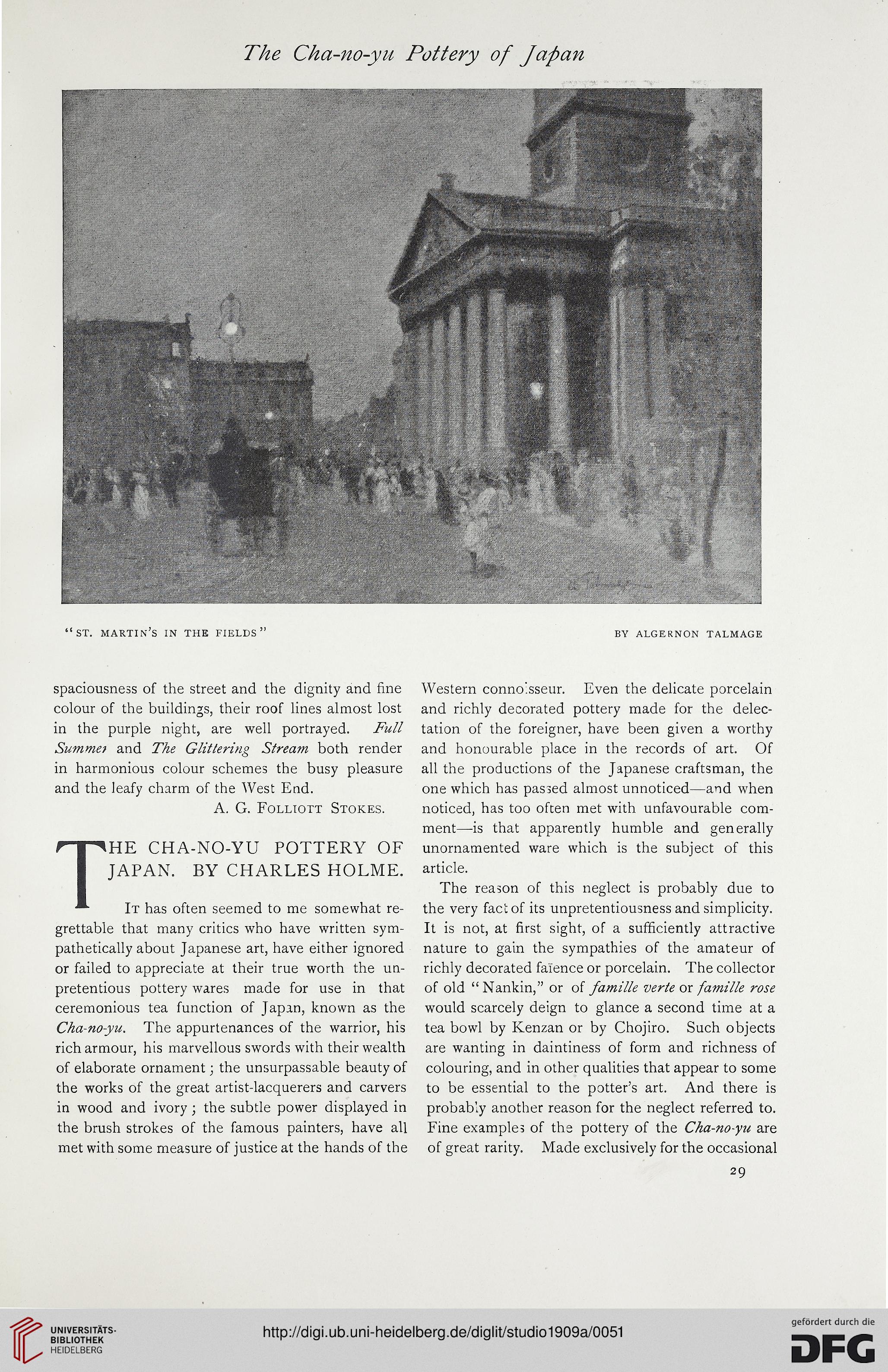The Cha-no-yu Pottery of Japan
“ ST. martin’s IN THE fields” BY ALGERNON TALMAGE
spaciousness of the street and the dignity and fine
colour of the buildings, their roof lines almost lost
in the purple night, are well portrayed. Full
Summer and The Glittering Stream both render
in harmonious colour schemes the busy pleasure
and the leafy charm of the West End.
A. G. Folliott Stokes.
T
HE CHA-NO-YU POTTERY OF
JAPAN. BY CHARLES HOLME.
It has often seemed to me somewhat re-
grettable that many critics who have written sym-
pathetically about Japanese art, have either ignored
or failed to appreciate at their true worth the un-
pretentious pottery wares made for use in that
ceremonious tea function of Japan, known as the
Cha-no-yu. The appurtenances of the warrior, his
rich armour, his marvellous swords with their wealth
of elaborate ornament; the unsurpassable beauty of
the works of the great artist-lacquerers and carvers
in wood and ivory; the subtle power displayed in
the brush strokes of the famous painters, have all
met with some measure of justice at the hands of the
Western connoisseur. Even the delicate porcelain
and richly decorated pottery made for the delec-
tation of the foreigner, have been given a worthy
and honourable place in the records of art. Of
all the productions of the Japanese craftsman, the
one which has passed almost unnoticed—and when
noticed, has too often met with unfavourable com-
ment—is that apparently humble and generally
unornamented ware which is the subject of this
article.
The reason of this neglect is probably due to
the very fact of its unpretentiousness and simplicity.
It is not, at first sight, of a sufficiently attractive
nature to gain the sympathies of the amateur of
richly decorated faience or porcelain. The collector
of old “Nankin,” or of famille verte or famille rose
would scarcely deign to glance a second time at a
tea bowl by Kenzan or by Chojiro. Such objects
are wanting in daintiness of form and richness of
colouring, and in other qualities that appear to some
to be essential to the potter’s art. And there is
probably another reason for the neglect referred to.
Fine examples of the pottery of the Cha-no-yu are
of great rarity. Made exclusively for the occasional
29
“ ST. martin’s IN THE fields” BY ALGERNON TALMAGE
spaciousness of the street and the dignity and fine
colour of the buildings, their roof lines almost lost
in the purple night, are well portrayed. Full
Summer and The Glittering Stream both render
in harmonious colour schemes the busy pleasure
and the leafy charm of the West End.
A. G. Folliott Stokes.
T
HE CHA-NO-YU POTTERY OF
JAPAN. BY CHARLES HOLME.
It has often seemed to me somewhat re-
grettable that many critics who have written sym-
pathetically about Japanese art, have either ignored
or failed to appreciate at their true worth the un-
pretentious pottery wares made for use in that
ceremonious tea function of Japan, known as the
Cha-no-yu. The appurtenances of the warrior, his
rich armour, his marvellous swords with their wealth
of elaborate ornament; the unsurpassable beauty of
the works of the great artist-lacquerers and carvers
in wood and ivory; the subtle power displayed in
the brush strokes of the famous painters, have all
met with some measure of justice at the hands of the
Western connoisseur. Even the delicate porcelain
and richly decorated pottery made for the delec-
tation of the foreigner, have been given a worthy
and honourable place in the records of art. Of
all the productions of the Japanese craftsman, the
one which has passed almost unnoticed—and when
noticed, has too often met with unfavourable com-
ment—is that apparently humble and generally
unornamented ware which is the subject of this
article.
The reason of this neglect is probably due to
the very fact of its unpretentiousness and simplicity.
It is not, at first sight, of a sufficiently attractive
nature to gain the sympathies of the amateur of
richly decorated faience or porcelain. The collector
of old “Nankin,” or of famille verte or famille rose
would scarcely deign to glance a second time at a
tea bowl by Kenzan or by Chojiro. Such objects
are wanting in daintiness of form and richness of
colouring, and in other qualities that appear to some
to be essential to the potter’s art. And there is
probably another reason for the neglect referred to.
Fine examples of the pottery of the Cha-no-yu are
of great rarity. Made exclusively for the occasional
29




